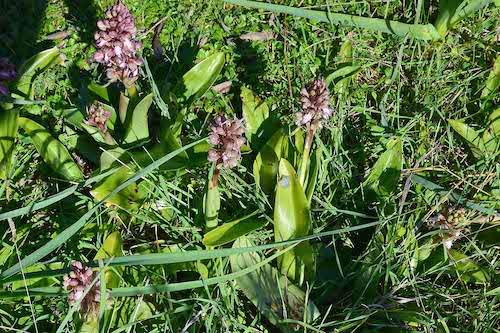Now that the African wood-sorell has emerged and declared its territory, on other parts of the island the anemones appear. They present a fiesta of colours, commencing with shades of white, pink and purple, until eventually the red ones overtake them all. It amazes me that the more you go to the south of the island the brighter the colours become, from bright rose to dark purple.
An early bird
The grape hyacynths slowly start showing their heavenly colours; if you look around carefully you might also see those fancy bonzai crocus, as I once called the Romulea linaresii. Small gold flowers fight with brutal blades of grass for a ray of sunshine. And there are the first orchids who are also emerging to look for a new spring.
There are some hundred orchid species on Lesvos, who with their small but lovely flowers (unlike the tropical kind) are not always remarkable. The early species already come out in January and February, like the Sitia orchid (Ophrys sitiaka) or the Small yellow mirror orchid (Ophrys sicula). Robert’s Giant Orchid (Himantoglossum robertianum) is also an early bird.
A Robertianum community
Sometimes you may see a lonely orchid in the landscape and you will look to see if some more family is hiding – most orchids do love to live in herds. Often they are easy to find along the roads and paths. A small number prefers to play hide and seek – like the Giant Robert Orchid. Even though they are amongst the largest orchids of the island (they can grow as high as 80 cm), they are not easy to bump into. Last week I fell upon a whole community of himantoglossum robertianum, hidden deeply between the small bushes of Avlonas. We counted some hundreds of them. What a party! Further away however there was the ‘black sheep’ of the family: a beautiful green/white one that, sad and alone, stood there radiating in its beauty between rock roses and lavender.
Jan van Lent
Himantoglossum is a sturdy family and they can be found until June on the island. They also grow on other islands, like Chios, and even in the Netherlands. Because the Robertianum is such an early bird, there are scientists claiming that this great flower is in fact a Barlia Robertiana. Jan van Lent, a local orchidologist, has chosen to call it a Himantoglossum. Jan van Lent follows the blossoming of as many orchids as possible. On his website ‘The Orchid Paradise: Lesvos, a Hornet’s nest!’, he has written about nearly all orchids of the island, where he also reports what other orchidologists have to say. Scientist do like to argue with each other, about origin, names and other scientific matters. An unbiased referee, Jan follows their arguing, makes a report and adds his own opinion.
Scientists
Theophrastus, founder of the biological study, born in Eresos, gave the orchid it name (orchis). G.N. Robert found the Robertiniana and added his name after Himantoglossum, but this scientist is barely visible on the internet. Father and son Candargy, two French biologists who visited Lesvos at the end of the Nineteenth century, have left more traces. They were the first ones to describe the flowers of Lesvos in their book Flore de l’ïle de Lesbos (1889), mentioning some seventeen orchids. The book is now available again.
There are still scientist absorbed in the nature of Lesvos, looking for orchids, or chasing after beetles, spiders and dragonflies. Regularly new discoveries are being made, but no new anaconda (like recently in the Amazon). There are plenty of snakes living on the island, but there is no risk that you’ll be attacked by a monster shooting out of a tree.
Ancient orchids
Things were different in ancient times – when there lived giant elephants, enormous turtles and other big game that you’d better do not meet during your walks. There are even stories about the existence of dragons. These creatures now have miniaturised and creep about in the guise of the intriguing salamanders found among the century-old stones of the island.
Sometimes I believe that there must be orchids that have lain hidden for centuries in the vast shrubbery of this island – ancient orchids, many times larger than those Robertiana. Lesvos is so big (although not having place for anacondas) that there are plenty of spaces where no human has ever gone, let alone a scientist. You’d nearly get gold fever knowing this.











